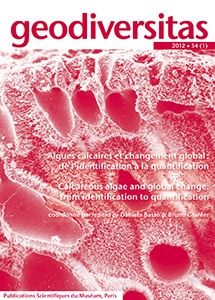
Although calcareous algae are known both in present environments and fossil records, from shelf and upper slope settings, either in warm seas for green algae or at all latitudes for red algae, we still need models to quantify their abundance in space and time, Calcareous algae are an important component of biogenic carbonate production but they are very sensitive to marine acidification and rise in temperature, as illustrated by the effects of ongoing global change, Contributions herein were first presented at the 6th Regional (European) Symposium of the International "Fossil Algae" Association: they include two reviews respectively devoted to the carbonate production of red and green algae, and a suite of investigations covering quantification, facies delineation, and controlling factors spanning the present-day Mediterranean Sea and Eastern Pacific going back to the Jurassic of Romania.
 Price :
Price :  Calcareous algae in changing environments
Calcareous algae in changing environments

 Carbonate production by calcareous red algae and global change
Carbonate production by calcareous red algae and global change

 The contribution of calcareous green algae to the production of limestones: a review
The contribution of calcareous green algae to the production of limestones: a review

 The contribution of calcareous algae to the biogenic carbonates of the continental shelf: Pontian Islands, Tyrrhenian Sea, Italy
The contribution of calcareous algae to the biogenic carbonates of the continental shelf: Pontian Islands, Tyrrhenian Sea, Italy
Valentina Alice BRACCHI & Daniela BASSO
61-76, Published on 30 March 2012, art. 34 (4)
 Maerl-bed mapping and carbonate quantification on submerged terraces offshore the Cilento peninsula (Tyrrhenian Sea, Italy)
Maerl-bed mapping and carbonate quantification on submerged terraces offshore the Cilento peninsula (Tyrrhenian Sea, Italy)
Alessandra SAVINI et al.
77-98, Published on 30 March 2012, art. 34 (5)
 Modern Rhodolith-dominated carbonates at Punta Chivato, Mexico
Modern Rhodolith-dominated carbonates at Punta Chivato, Mexico
Jochen HALFAR et al.
99-113, Published on 30 March 2012, art. 34 (6)
 Palaeoenvironmental and stratigraphic significance of Pliocene rhodolith beds and coralline algal bioconstructions from the Carboneras Basin (SE Spain)
Palaeoenvironmental and stratigraphic significance of Pliocene rhodolith beds and coralline algal bioconstructions from the Carboneras Basin (SE Spain)
Julio AGUIRRE et al.
115-136, Published on 30 March 2012, art. 34 (7)
 Quantification of the coralline carbonate from a Serravallian rhodolith bed of the Tertiary Piedmont Basin (Stazzano, Alessandria, NW Italy)
Quantification of the coralline carbonate from a Serravallian rhodolith bed of the Tertiary Piedmont Basin (Stazzano, Alessandria, NW Italy)
Daniela BASSO et al.
137-149, Published on 30 March 2012, art. 34 (8)
 Coralline algae as environmental indicators: a case study from the Attard member (Chattian, Malta)
Coralline algae as environmental indicators: a case study from the Attard member (Chattian, Malta)
Francesca QUARANTA et al.
151-166, Published on 30 March 2012, art. 34 (9)
 Rudist-bearing rhodalgal facies in the post-Turonian recovery of peri-Tethyan carbonate systems: a case history from the Nurra region (northwestern Sardinia, Italy)
Rudist-bearing rhodalgal facies in the post-Turonian recovery of peri-Tethyan carbonate systems: a case history from the Nurra region (northwestern Sardinia, Italy)
Lucia SIMONE et al.
167-187, Published on 30 March 2012, art. 34 (10)
 Temporal changes in biotic and abiotic composition of shallow-water carbonates on submerged seamounts in the northwestern Pacific Ocean and their controlling factors
Temporal changes in biotic and abiotic composition of shallow-water carbonates on submerged seamounts in the northwestern Pacific Ocean and their controlling factors
Hideko TAKAYANAGI et al.
189-217, Published on 30 March 2012, art. 34 (11)
 Large dasycladalean algae from Upper Jurassic limestone deposits of the Apuseni Mountains (Romania) – habitat and depositional environment
Large dasycladalean algae from Upper Jurassic limestone deposits of the Apuseni Mountains (Romania) – habitat and depositional environment
Ioan I. BUCUR & Emanoil SĂSĂRAN
219-239, Published on 30 March 2012, art. 34 (12)